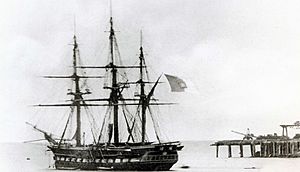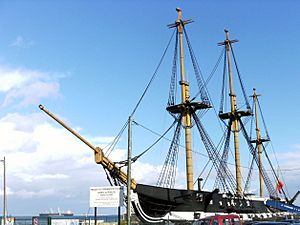Dom Fernando II e Glória facts for kids

Dom Fernando II e Glória, anchored in Ponta Delgada, Azores, during her last sea mission in 1878
|
|
Quick facts for kids History |
|
|---|---|
| Name | Dom Fernando II e Glória |
| Ordered | 1821 |
| Builder | Shipyards of the Royal Navy Arsenal at Daman, Portuguese India |
| Launched | 22 October 1843 |
| Maiden voyage | 2 February 1845 |
| In service | 1845 |
| Status | Preserved as a museum ship in Almada, Portugal |
| General characteristics | |
| Class and type | 50-gun frigate |
| Displacement | 1,849.16 tons |
| Length | 284 ft (87 m) |
| Beam | 42 ft (13 m) |
| Draught | 21 ft (6.4 m) |
| Propulsion | Sails - 22,190 sq ft (2,062 m2) |
| Sail plan | Full-rigged ship |
| Speed | 8 knots (15 km/h; 9.2 mph) |
| Boats & landing craft carried |
|
| Complement | 145 to 379 crew. 270 passengers. |
| Armament | |
The Dom Fernando II e Glória is a famous old sailing ship from the Portuguese Navy. She is a frigate, which means she was a type of warship with many guns. This ship was built mostly from wood.
She was launched in 1843 and began her first journey in 1845. The ship was built in Daman, which was a Portuguese area in India. She was the very last sailing warship built for Portugal. She also made the last "India Run," a regular trip connecting Portugal to its colonies in India.
After serving for many years, she became a training ship for the navy's Artillery School in 1865. She kept this job until 1940. The ship sailed more than 100,000 miles, which is like going around the world five times! Her last sea trip was in 1878.
In 1963, a big fire almost destroyed her. For 29 years, her burned wooden body lay in the mud of the Tagus river. But in 1990, the Portuguese Navy decided to fix her up. They wanted her to look like she did in the 1850s.
Today, the Dom Fernando II e Glória is a museum ship. She was a big attraction at the World Exhibition of 1998 in Lisbon. Since 2008, you can visit her in Cacilhas, Almada, on the Tagus river.
Building a Historic Ship
In 1821, a Portuguese official in Goa suggested building a new frigate. He thought it should be built in Daman, another Portuguese colony in India. This area had a lot of teak wood, which was excellent for building ships.
The Portuguese king, João VI, approved the building in 1824. However, a civil war and other problems in Portugal caused many delays. The ship was built by Portuguese and Indian workers. Finally, she was launched in 1843. Then, she was taken to Goa to be fully equipped as a full-rigged ship.
The ship was named after Ferdinand II, who was the husband of the Portuguese Queen Maria II. She was also named after "Our Lady of Glory," a religious figure important to people in Goa. The frigate was known for having lots of space inside. This was important for long journeys that could last three months or more without stopping.
Life at Sea: The Ship's Journeys
The Dom Fernando II e Glória made her first voyage from Goa to Lisbon. This trip happened between February and July 1845. Captain Torcato José Marques led the ship with a crew of 145 men.
Over the years, the ship was used for many different missions:
- She carried soldiers, new settlers, and government officials. She also transported people to Portuguese colonies in Africa and India.
- In 1852, she took Empress Amélie of Leuchtenberg of Brazil and her daughter to the island of Madeira. Her daughter was sick and hoped the climate would help her get better.
- In 1854, she transported the Portuguese explorer António da Silva Porto and his team. They had just finished crossing Africa from Angola to Mozambique.
- In May 1855, she was the main ship in a Portuguese navy group. They went to Ambriz, Angola, to help stop a local uprising.
- In 1860, she helped with the settlement of Huíla, Angola. She carried sheep and horses from South Africa to Angola.

Top left to bottom left: The Dom Fernando II e Glória. Sailors loading a Krupp gun. The Captain's quarters antechamber. Sailors aiming an Armstrong gun.
Center: The Captain and officers of the ship.
Top right to bottom right: Sailors firing a Canet cannon. Petty officers next to an Armstrong gun. The Captain's quarters. The ship's crew.
In 1865, the Dom Fernando II e Glória became the new Artillery School ship. She trained sailors until 1878. On her last training trip to the Azores islands, she rescued the crew of an American ship called Lawrence Boston. Their ship had caught fire.
After this, she stayed in Lisbon as the Naval Artillery School. In 1889, she was changed quite a bit. Her masts were replaced, and new gun platforms were added. This helped her better serve as a training unit for artillery. In 1938, she was the main ship for the naval forces in Portugal.
Fire and Restoration
In 1940, the ship was no longer fit for navy service. She became the home of a welfare organization. This group helped young people learn general education and seamanship. But on April 3, 1963, a huge fire broke out during repair work. The fire badly damaged the ship's body and structure.
After the fire, the frigate was moved to a quiet part of the Tagus river. She was left there, half-buried in the mud, for 29 years.
In October 1990, the Portuguese Navy decided to restore the frigate. They wanted her to look like she did in the 1850s. This big project was led by Rear Admiral Francisco de Figueiredo e Silva Cunha Salvado.
On January 22, 1992, the wooden hull was lifted from the mud. It was then floated and taken to different shipyards for repair. The restoration took five years and received a lot of public and private support. On April 27, 1998, the Dom Fernando II e Glória officially rejoined the Portuguese Navy. She was now an Auxiliary Navy Unit.
On August 12, 1998, she became part of the Navy Museum. She was a huge hit at Expo '98, which celebrated 500 years since Vasco da Gama found the sea route to India. Almost 900,000 people visited her!
In September 1998, the World Ship Trust gave the Dom Fernando II e Glória a special award. They called her restoration one of the most amazing historic ship preservation achievements. The International Register of Historic Ships considers her the fourth oldest armed frigate and the eighth oldest sailing warship in the world.
See also
- NRP Adamastor
- NRP Afonso de Albuquerque (1884)
- NRP Sagres (1937)


